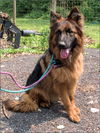|
All Shepherd Rescue
Your next best friend is waiting for you
|
HomeAnimalsAbout UsContact Us | |
Training - Separation AnxietyReducing Separation Anxiety in DogsYou can download this article as a PDF by clicking here and keep it handy for yourself or share it with someone you know.
Why Do Dogs Suffer from Separation Anxiety? We don’t fully understand why some dogs suffer from separation anxiety and, under similar circumstances, others don’t. It’s important to realize, however, that the destruction and house soiling that often occur with separation anxiety are not the dog’s attempt to punish or seek revenge on his owner for leaving him alone. In reality, they are part of a panic response. Separation Anxiety Sometimes Occurs:
How Do I Know If My Dog Has Separation Anxiety? Because there are many reasons for the behaviors associated with separation anxiety, it’s essential to correctly diagnose the reason for the behavior before proceeding with treatment. If most, or all, of the following statements are true about your dog, he may have a separation anxiety problem:
What to Do If Your Dog Has Separation Anxiety For a minor separation anxiety problem, the following techniques may be helpful by themselves. For more severe problems, these techniques should be used along with the desensitization process described in the next section. Keep arrivals and departures low-key. For example, when you arrive home, ignore your dog for the first few minutes, then calmly pet him. This may be hard for you to do, but it’s important! Leave your dog with an article of clothing that smells like you—such as an old t-shirt that you’ve slept in recently. Establish a “safety cue”—a word or action that you use every time you leave that tells your dog you’ll be back. Dogs usually learn to associate certain cues with short absences by their owners. For example, when you take out the garbage, your dog knows you come right back and doesn’t become anxious. Therefore, it’s helpful to associate a safety cue with your short-duration absences. Some examples of safety cues are a playing radio, a playing television, or a toy (one that doesn’t have dangerous fillings and can’t be torn into pieces). Use your safety cue during practice sessions with your dog. Be sure to avoid presenting your dog with the safety cue when you leave for a period of time longer than he can tolerate; if you do, the value of the safety cue will be lost. Leaving a radio on to provide company for your dog isn’t particularly useful by itself, but a playing radio may work if you’ve used it consistently as a safety cue in your practice sessions. If your dog engages in destructive chewing as part of his separation distress, offering him a chewing item as a safety cue is a good idea. Very hard rubber toys that can be stuffed with treats and Nylabone®-like products are good choices. Desensitization Techniques for More Severe Cases of Separation Anxiety The primary treatment for more severe cases of separation anxiety is a systematic process of getting your dog used to being alone. You must teach your dog to remain calm during “practice” departures and short absences. We recommend the following procedure:
Proceed very gradually from step to step, repeating each step until your dog shows no signs of distress. The number of repetitions will vary depending on the severity of the problem. If at any time in this process your actions produce an anxiety response in your dog, you’ve proceeded too fast. Return to an earlier step in the process and practice this step until the dog shows no distress response, then proceed to the next step. Once your dog is tolerating your being on the other side of the door for several seconds, begin short-duration absences. This step involves giving the dog a verbal cue (for example, “I’ll be back”), leaving, and then returning within a minute. Your return must be low-key: Either ignore your dog or greet him quietly and calmly. If he shows no signs of distress, repeat the exercise. If he appears anxious, wait until he relaxes to repeat the exercise. Gradually increase the length of time you’re gone. Practice as many absences as possible that last less than 10 minutes. You can do many departures within one session if your dog relaxes sufficiently between departures. You should also scatter practice departures and short-duration absences throughout the day. Once your dog can handle short absences (30–90 minutes), he’ll usually be able to handle longer intervals alone, and you won’t have to repeat this process every time you are planning a longer absence. The hard part is at the beginning, but the job gets easier as you go along. Nevertheless, you must go slowly at first. How long it takes to condition your dog to being alone depends on the severity of his problem. Teaching the Sit-Stay and Down-Stay Another technique for reducing separation anxiety in your dog is practicing the common “sit-stay” or “down-stay” training exercises using positive reinforcement. Your goal is to be able to move briefly out of your dog’s sight while he remains in the “stay” position and thereby teach your dog that he can remain calmly and happily in one place while you go to another. To do this, you gradually increase the distance you move away from your dog. As you progress, you can do this during the course of your normal daily activities. For example, if you’re watching television with your dog by your side and you get up for a snack, tell him to stay, and leave the room. When you come back, give him a treat or praise him quietly. Never punish your dog during these training sessions. Interim Solutions Because the treatments described above can take a while, and because a dog with separation anxiety can do serious damage to himself or your home in the interim, consider these suggestions to help you and your dog cope in the short term. Consult your veterinarian about the possibility of drug therapy. A good anti-anxiety drug should not sedate your dog, but simply reduce his anxiety while you’re gone. Such medication is a temporary measure and should be used in conjunction with behavior modification techniques.
What Won’t Help a Separation Anxiety Problem Punishing your dog. Punishment is not an effective way to treat separation anxiety. In fact, punishing your dog after you return home may actually increase his separation anxiety. Getting another pet as a companion for your dog. This usually doesn’t help an anxious dog because his anxiety is the result of his separation from you, his person, not merely the result of being alone. Crating your dog. Your dog will still engage in anxiety responses in the crate. He may urinate, defecate, howl, or even injure himself in an attempt to escape from the crate. Leaving the radio on (unless the radio is used as a “safety cue,” as described above). Training your dog. While formal training is always a good idea, it won’t directly help a separation anxiety problem. Separation anxiety is not the result of disobedience or lack of training; it’s a panic response. You can download this as a PDF here and keep it handy for yourself or share it with someone you know. Adapted from material originally developed by applied animal behaviorists at the Dumb Friends League, Denver, Colorado. ©2000 Dumb Friends League and ©2003 The HSUS. All rights reserved. |











